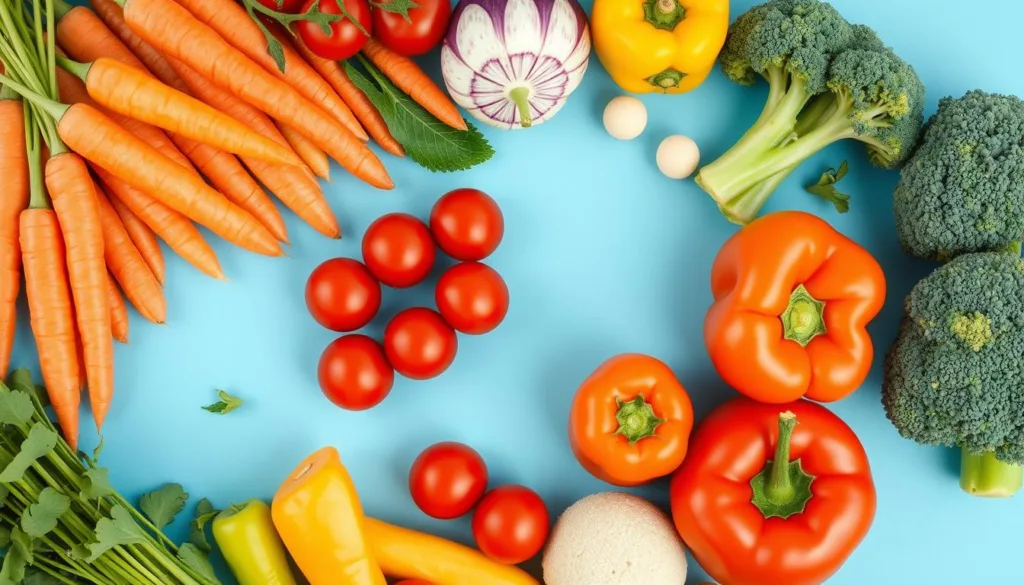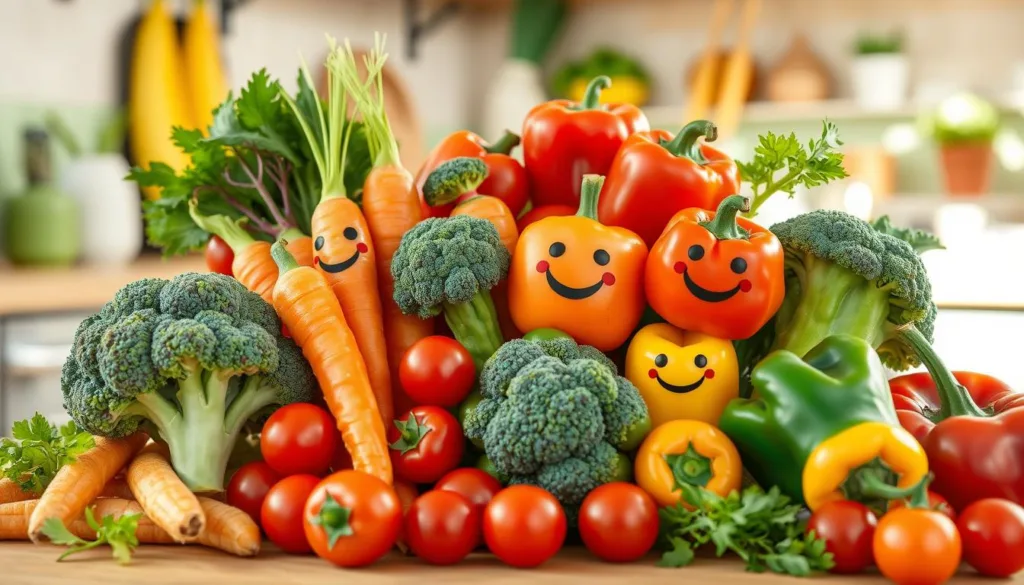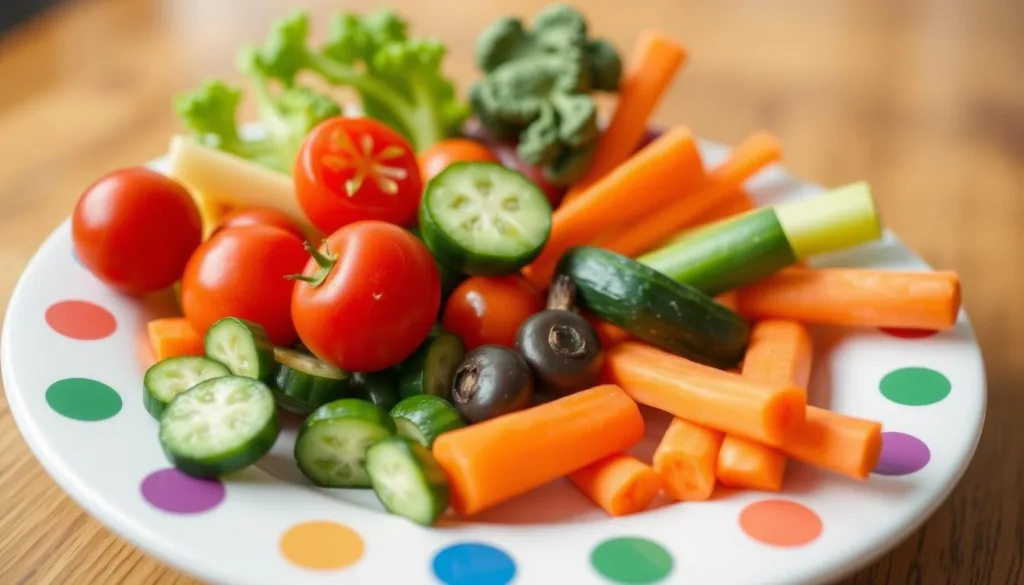Finding Best Vegetables for Preschoolers is a fun journey. It’s not just about food; it’s about making mealtime special. A healthy diet is key for their growth and happiness.
Vegetables for kids come in bright colors and fun shapes. Bell peppers, for example, are a rainbow of colors. They make eating veggies a fun, colorful experience.
Choosing the right veggies means picking ones that are both healthy and tasty. Sweet potatoes are sweet and full of fiber. Carrots are crunchy and packed with vitamins. These make eating healthy a joy.
Key Takeaways
- Introduce colorful vegetables to make meals exciting
- Choose nutrient-rich options with appealing textures
- Make vegetable eating a positive, enjoyable experience
- Experiment with different preparation methods
- Involve children in selecting and preparing vegetables
Table of Contents
Understanding the Importance of Vegetables in Preschooler’s Diet
Vegetables are packed with nutrients that are vital for preschoolers. They help your child’s body grow strong and healthy. They also teach good eating habits for life.

Discovering the benefits of vegetables shows why they’re key for your child’s health. Green veggies, in particular, are full of nutrients. They support growth and health in many ways.
Nutritional Benefits for Growing Bodies
Green veggies are a treasure trove of nutrients for your preschooler. They offer:
- Rich in vitamins A, C, K, calcium, and iron
- Low in calories and sugar
- High in antioxidants like beta-carotene
- Excellent source of dietary fiber
Role in Development and Growth
Vegetables are packed with nutrients that help your child grow. They support brain health and growth. Nutrients like Vitamin K, lutein, and folate are especially important.
| Vegetable | Key Nutrient | Developmental Benefit |
|---|---|---|
| Spinach | Vitamin K | Heart health support |
| Broccoli | Vitamin C | Immune system strengthening |
| Carrots | Beta-carotene | Vision and cellular protection |
Building Healthy Eating Habits Early
Introducing veggies early is key for healthy eating habits. Kids might need to try new foods up to 10 times before liking them. Be patient and positive to encourage them.
“Offering praise when a child tries vegetables makes them more likely to eat vegetables again.” – Nutrition Experts
By making veggies a regular part of your child’s diet, you’re investing in their health. You’re supporting their growth and teaching them about nutrition.
Best Vegetables for Preschoolers: Essential Guide

Introducing healthy veggies to kids can be fun for parents. Your toddler vegetable guide is here, filled with colorful and tasty options for healthy eating!
“Eating vegetables is like a superpower for growing kids!” – Pediatric Nutrition Expert
Choosing the right veggies for kids means picking ones that are both nutritious and tasty. Let’s look at the best options that will make your preschooler love eating greens.
- Bell Peppers: A rainbow of colors that make eating fun!
- Carrots: Crunchy and sweet nutritional powerhouses
- Sweet Potatoes: Packed with essential nutrients
- Broccoli: The superhero of vegetable nutrition
Introducing veggies can be tough for parents. But, the right approach can change everything. Variety and presentation are key to helping kids love healthy foods.
| Vegetable | Key Nutrients | Kid Appeal |
|---|---|---|
| Carrots | Beta-carotene, Fiber | Sweet, Crunchy |
| Spinach | Vitamin K, Antioxidants | Soft, Mild Flavor |
| Sweet Potatoes | Potassium, Fiber | Naturally Sweet |
Only 10% of kids eat enough veggies every day. The early years are key for healthy eating habits. Experts say kids might need to try a veggie 10 times before they like it.
Pro tip: Make eating veggies fun by letting your child help in the kitchen. Show them how to make veggies colorful and fun to eat.
Sweet and Colorful Vegetables Your Child Will Love
Introducing veggies to preschoolers can be fun. Focus on sweet, colorful, and fun-shaped veggies. They make mealtime exciting and fun for kids.

Naturally Sweet Vegetable Delights
Some veggies are naturally sweet, which kids love. Carrots are a top choice, full of beta-carotene and fiber. Sweet potatoes are another great option, offering nutrients and taste.
- Carrots: Crunchy and naturally sweet
- Sweet Potatoes: Creamy and nutritious
- Beets: Vibrant and naturally sugary when cooked
- Corn: A classic sweet vegetable favorite
Rainbow of Colorful Veggies
Fun-shaped produce makes meals exciting. Colorful veggies turn a simple plate into a feast. It sparks kids’ imagination.
| Color | Vegetable | Nutritional Benefit |
|---|---|---|
| Red | Cherry Tomatoes | Rich in Vitamin C |
| Orange | Bell Peppers | High in Vitamin A |
| Green | Broccoli | Boosts Immune System |
| Purple | Eggplant | Antioxidant-rich |
Playful Vegetable Shapes
Make veggies fun by shaping them. Broccoli “trees,” cauliflower “popcorn,” and spiral-cut zucchini make eating veggies a fun game for kids.
“Making vegetables fun is the key to getting kids to eat them!” – Pediatric Nutritionist
With these ideas, veggies can be a fun part of your child’s diet. They’ll get the nutrients they need while enjoying their meals.
Easy-to-Eat Vegetables for Small Hands

Introducing bite-sized vegetables can make snack time fun for preschoolers. Only 60% of kids eat enough veggies, making creative snacks important for their health.
“Making vegetables fun and accessible is key to helping children develop healthy eating habits.”
Kid-friendly veggie snacks should be small, colorful, and easy to handle. Here are top recommendations for finger foods for toddlers:
- Baby carrots
- Cherry tomatoes (halved for safety)
- Cucumber rounds
- Snap peas
- Steamed broccoli florets
- Roasted sweet potato cubes
Cutting vegetables into manageable, bite-sized pieces helps develop fine motor skills while making eating enjoyable. Presentation matters! Creating visually appealing vegetable platters can increase children’s interest in trying new foods.
| Vegetable | Preparation Tip | Nutrition Benefit |
|---|---|---|
| Carrots | Cut into thin sticks | High in Vitamin A |
| Cucumber | Slice into rounds | Hydrating, low calories |
| Broccoli | Steam and cut into small florets | Rich in Vitamin C |
Parents can make veggies more appealing by offering fun dips like hummus or yogurt-based sauces. The CDC says introducing veggies as snacks can greatly increase kids’ veggie intake.
Creative Ways to Serve Vegetables to Picky Eaters
Changing how you present vegetables to kids needs creativity and patience. It’s tough to get preschoolers to eat healthy foods. But, with the right approach, you can make veggies fun and tasty.
Fun Presentation Ideas
How something looks is key to getting kids to try veggies. Here are some fun ways to present them:
- Create vegetable “faces” on plates using colorful produce
- Design vegetable kebabs with rainbow-colored vegetables
- Make mini vegetable “trees” using broccoli and cauliflower
- Use cookie cutters to shape vegetables into fun designs
Healthy Dips for Vegetables
Getting kids to help in the kitchen is easier with tasty dips. Here are some dips that kids love:
| Dip Type | Kid Appeal | Nutritional Bonus |
|---|---|---|
| Hummus | Creamy texture | Protein-rich |
| Yogurt-based sauce | Mild flavor | Calcium boost |
| Light ranch | Familiar taste | Encourages vegetable eating |
Interactive Meal Preparations
Make mealtime fun by letting kids help. They can wash veggies, arrange them, or help cook. This builds their confidence in the kitchen and makes eating veggies fun.
Research shows that consistently offering fruits and vegetables to children in a neutral manner will eventually lead them to try the produce.
Remember, patience is key. Every small step helps in teaching your preschooler to eat healthy.
Seasonal Vegetable Guide for Preschoolers
Exploring seasonal produce can make mealtime fun. Knowing which veggies are in season helps parents keep meals fresh and tasty.
Each season brings its own special veggies. These can excite your preschooler’s taste buds and meet their nutritional needs.
Seasonal Vegetable Highlights
- Spring: Asparagus, peas, and tender spinach burst with vibrant flavors
- Summer: Colorful tomatoes, crisp zucchini, and sweet bell peppers reign supreme
- Fall: Hearty pumpkins, sweet potatoes, and Brussels sprouts provide rich nutrients
- Winter: Robust carrots, creamy cauliflower, and comforting winter squash offer warmth
“Eating with the seasons connects children to nature’s rhythms and local food production.”
Your preschooler can learn about agriculture, nutrition, and flavor diversity. This is all through seasonal veggies.
| Season | Kid-Friendly Vegetables | Nutrition Highlights |
|---|---|---|
| Spring | Peas, Spinach | High in Iron, Vitamin K |
| Summer | Tomatoes, Zucchini | Rich in Vitamin C, Hydrating |
| Fall | Pumpkin, Sweet Potatoes | Loaded with Beta-Carotene |
| Winter | Carrots, Cauliflower | Packed with Antioxidants |
By changing veggies with the seasons, meals stay fun and full of nutrients for your child.
Common Challenges and Solutions in Vegetable Introduction
Introducing veggies to preschoolers can be tough for parents. Picky eaters often make it hard to get them to accept vegetables. Knowing these challenges helps in finding ways to make veggies more appealing.
Parents often face resistance when trying to get their kids to eat more veggies. It takes patience, creativity, and smart strategies to help kids accept vegetables.
Dealing with Food Refusal
Food refusal is a big challenge in getting kids to eat veggies. Kids might not like veggies because of how they taste or feel. Here are some tips:
- Offer small “try bites” without pressure
- Keep introducing the same veggie
- Respect their food choices
- Don’t react badly if they say no
Texture Preferences Matter
Texture is very important for kids when it comes to veggies. Some like crunchy raw veggies, while others prefer soft cooked ones. Try different ways to prepare veggies:
- Steamed veggies with a bit of seasoning
- Raw veggie sticks
- Pureed veggie sauces
- Roasted veggie chips
Making Vegetables Appealing
“Children eat with their eyes first” – Pediatric Nutrition Experts
How you present veggies can make a big difference. Let your child help with meal prep, use bright colors, and make fun shapes. Activities like gardening or cooking together can also encourage kids to try new foods.
Remember, being patient is crucial. Keep showing kids veggies in a positive way. Over time, they will start to enjoy them more.
Health Benefits and Nutritional Value
Vegetable nutrition is key for kids’ healthy growth. A balanced diet is vital for strong bodies and overall health. Colorful veggies make mealtime fun and packed with nutrients.
Vegetables offer more than just food. They bring unique benefits for kids:
- Bell peppers add vibrant colors and important vitamins
- Carrots are good for the eyes with beta-carotene
- Spinach helps the brain and heart
- Broccoli boosts the immune system
Discover the nutritional wonders for your child’s health:
| Vegetable | Key Nutrients | Health Benefits |
|---|---|---|
| Sweet Potatoes | Fiber, Vitamin B6, Potassium | Supports growth, low in cholesterol |
| Avocados | Essential Fatty Acids | Promotes brain function |
| Peas | Protein, Vitamins | Aids brain cell development |
“Eating a variety of vegetables helps children protect against diseases and ensures healthy growth” – Pediatric Nutrition Research
Introducing new veggies to kids takes time and effort. Patience and creativity are key in making healthy foods appealing. Every veggie bite is a step towards your child’s health and growth.
Conclusion
Adding vegetables to your preschooler’s diet is key for lifelong healthy eating. It’s not just about nutrition; it’s about setting them up for growth and health. Studies show that introducing many vegetables early can greatly benefit their health later on.
It’s not hard to get kids to eat veggies. Make them fun and engaging. Try creative ways to serve them and let kids help in the kitchen. Be patient, as it might take time for them to like new foods.
The health benefits are huge. Eating lots of veggies can lower the risk of serious health problems. For example, eating over 5 servings a day can cut heart disease risk by 20%. Starting healthy eating habits early is a big gift for your child’s future health.
Your approach is crucial. Make eating veggies a positive experience. Lead by example and support them every step of the way. Every bite they take is a step towards a healthier life.
FAQ
Why are vegetables important for preschoolers?
Vegetables are full of vitamins, minerals, and fiber. They help your child grow strong and healthy. They boost the immune system, aid digestion, and support overall health.
Which vegetables are most kid-friendly?
Kid-friendly veggies include bell peppers, carrots, peas, broccoli, cherry tomatoes, and sweet potatoes. They are sweet, colorful, and fun to eat.
How can I encourage my picky eater to try vegetables?
Make veggies fun by making faces or using colorful kebabs. Offer small dips and let your child help with meal prep. Be patient and keep offering new veggies.
What are the best ways to prepare vegetables for preschoolers?
Cut veggies into small, easy-to-handle pieces. Try steaming broccoli or roasting for sweetness. Fun shapes can also make them more appealing.
How many vegetables should my preschooler eat daily?
Aim for 1-2 cups of veggies daily, based on age and appetite. Include a variety of colors for nutrients. Start small and increase as they get used to new veggies.
Are raw or cooked vegetables better for preschoolers?
Both raw and cooked veggies have benefits. Raw ones keep nutrients and texture. Cooked ones are easier to chew and digest. Let your child decide what they like best.
How can I make vegetables more appealing to my child?
Use colorful presentation and fun shapes. Offer dips and let them help with meal prep. Serve with familiar foods and enjoy veggies yourself.
What if my child absolutely refuses to eat vegetables?
Stay patient and keep offering veggies. Try different ways of serving and cooking. It may take time for them to accept new foods. Consider blending veggies into smoothies.
Are frozen or fresh vegetables better?
Both are nutritious. Frozen veggies are picked at peak ripeness. They’re convenient and cost-effective for quick meals.
How can I introduce new vegetables to my preschooler?
Start with small portions of new veggies with familiar foods. Offer them multiple times without forcing. Encourage trying new foods and praise their efforts.











